
- CLASSIFIEDS
- NEWSLETTERS
- SUBMIT NEWS


Portsmouth to host race start and finish of Clipper Round the World Yacht Race
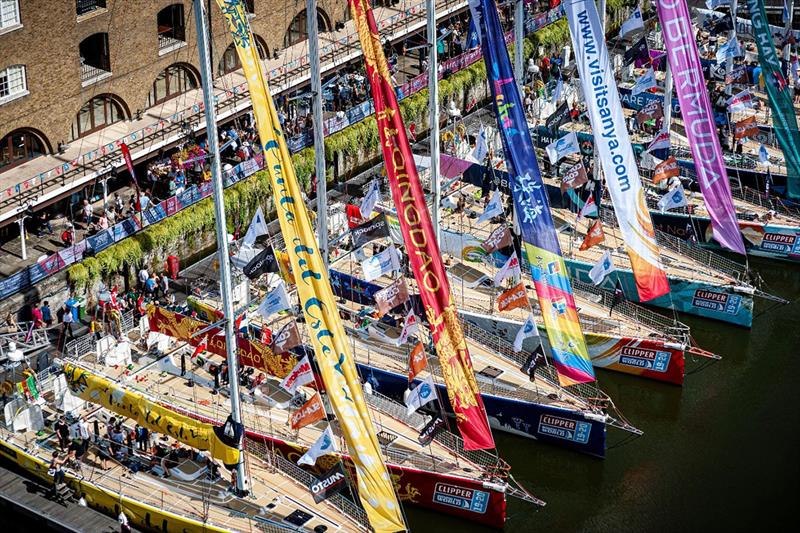
Related Articles
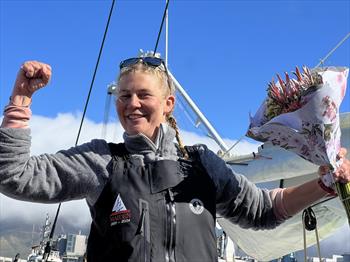

Published on August 30th, 2022 | by Editor
Preparing for Clipper Race 2023-24
Published on August 30th, 2022 by Editor -->
The 2019-2020 Clipper Round the World Yacht Race was to finish in just under one year, but when the teams arrived in Asia during the pandemic, with health restrictions postponing further progress, it would take nearly three years to complete this contest for amateur crews led by a professional skipper.
But with the twelfth edition crossing the final finish line in July 2022 , which was the fourth circumnavigation for the 11 Clipper 70 racing yachts, it was time to get them to HQ in Portsmouth Harbour, UK and ready them for the start of the next race.
Having just crossed over 40,000 nautical miles though some of the most inhospitable stretches of the world’s oceans, withstanding both extreme heat and freezing temperatures, the equally-matched purpose-built fleet will undergo an extensive decommissioning, refitting and commissioning process ahead of the Clipper 2023-24 Race.
No stone is left unturned as the 20-strong team of both dedicated refit and Clipper Race maintenance staff will invest approximately 35,000 work hours to strip out, lift, inspect, maintain, clean, and, where necessary, repair or replace parts or fittings.

Justin ‘Jay’ Haller, Chief Engineer, has been with the Clipper Race for 20 years. He has worked on every generation of Clipper Race ocean racing yachts and oversees the mammoth refit operation.
“These boats are over-specced compared to what you’d see on a regular yacht,” said Haller. “Everything down to the thickness of the hull is over-specced. So although I’m not surprised, I’m pleased to see that the boats have held up really, really well. I have no qualms about them doing another race. There are some cosmetic repairs, naturally, but that’s to be expected. “The boats come out of the water for 36 days and we work on them two at a time. After the masts are removed, one of the first jobs we do is take the generators and main engines out to work on them in the yard.”
Former race skipper Dan Jones is part of the refit team and has been overseeing the first engine lift. “When we lift the engines, we have to disconnect the gear box and the shaft to the propeller,” he explains. “We then have to disconnect the fuel lines and the water pipes, battery cables, alternators, mounts and then the actual engine mount.
“We can lift the engine through the hatch on deck and then lower it to the hanger floor so that we can sandblast the brackets, replace the mounts, remove and service the raw water pumps, remove the alternators to send them away for a strip and service. Once it’s out it’s much easier to do that way.”
Scheduling the work is a task in itself to ensure the yachts are ready in time for the next intake of training and to fulfil Clipper Events sailing commitments. The workload is extensive, as Haller explains: “Each boat is stripped, sanded and painted in the interior. Once painted, we replace all the piping – saltwater, freshwater, all of it as a matter of course. The floorboards are then inspected and if any are damaged they will either be sanded down, repainted and covered with kiwi grip – or replaced if necessary. The gas infrastructure is replaced as a matter of course.
“Each yacht’s wiring gets inspected and replaced, then all the standing rigging is stripped off and replaced. At this point, we often get the team at Sta-Lok to take a look at the fittings that have come off so they can see how well it has stood up against the elements and for future product development. The masts are inspected and stress tested where necessary.
“We have had surveyors down who confirmed that there’s nothing major we need to do. However, we will still remove the keel bolts and inspect them as a matter of course to see if there is any corrosion on the keel and to check the bolts themselves.”
For the first time, thanks to the Coppercoat covering, the Clipper Race fleet doesn’t need antifouling – saving time and reducing the refit’s carbon footprint with the environmentally responsible coating. “The Coppercoat has lasted REALLY well!” noted Haller. “Each of the hulls will have a light sand.
“We had a rudder for one of the boats rebuilt in Cape Town which we didn’t have time to Coppercoat, so we had to use regular antifoul on it. It’s a stark comparison, it has about half an inch of growth on it, whereas the rest of the boat had Coppercoat, including the yacht’s other rudder and it was as good as new with just a simple pressure wash.”
The refit also offers Haller and his team the chance to update, upgrade, or make changes to improve performance, comfort or the sailing experience for future race crews. Once back in the water, each yacht has its mast, which has also undergone full inspection and had each wire replaced, restepped and is rigged with a whopping 1,439m (excluding spares) of Marlow Ropes lines.
There’s no rest for the refit team, which is split up to tag team the conveyor belt process of each stage of the refit. “A week before the pair of yachts are ready to go back in the water, we begin decommissioning the next pair of yachts,” said Haller. “Everything comes off and goes into a container, and then will swap over with the current two yachts which be recommissioned and ready to go.”
Once the yachts are back in the water, the refit team thoroughly tests the systems before they are used again. But even when the entire fleet has been through refit, and systems are checked, the inspections don’t stop. “The fleet is Cat2 registered – for UK inshore and coastal sailing – until Race Start,” explained Haller. “Then before the race they have the CAT0 survey which is another in depth survey.”
The Clipper Race is looking to expand its refit team, and is hiring refit staff to help ensure the fleet is race ready ahead of the 2023-24 edition. Find out more via the Clipper Race careers page .
The Clipper Round the World Yacht Race was established in 1996 by Sir Robin Knox-Johnston, the first person to sail solo non-stop around the world in 1968-69. His aim was to allow anyone, regardless of previous sailing experience, the chance to embrace the thrill of ocean racing; it is the only event of its kind for amateur sailors.
Held biennially, the 2019-20 Clipper Race got underway September 1 for the fleet of eleven identical Tony Castro designed Clipper 70s. As the most subscribed round the world race, the 12th edition had attracted 688 crew representing 43 nationalities for the 41,000+ nm course.
However, when the fleet arrived in Asia, the COVID-19 pandemic blocked the fleet from the planned routes in China. The 11 Clipper 70s remained at Subic Bay Yacht Club in the Philippines since March 2020 after organizers and Race Crew were forced to return home due to pandemic restrictions. The race restarted in March 2022 and finally concluded in July 2022.
Race details: www.clipperroundtheworld.com

Tags: Clipper Round the World Yacht Race
Related Posts
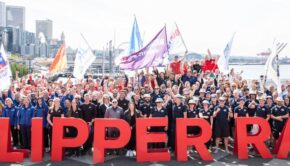
Clipper Race: From Seattle to Panama →
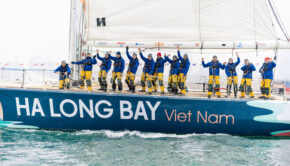
Clipper Race: Winning the China-USA leg →
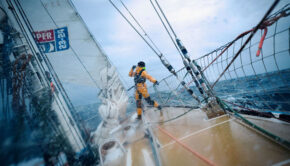
Clipper Race arrival imminent in USA →
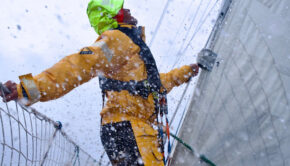
Clipper Race: Time has no meaning →
© 2024 Scuttlebutt Sailing News. Inbox Communications, Inc. All Rights Reserved. made by VSSL Agency .
- Privacy Statement
- Advertise With Us
Get Your Sailing News Fix!
Your download by email.
- Your Name...
- Your Email... *
- Comments This field is for validation purposes and should be left unchanged.

Your Teams. All Sources.
© 2024 BVM Sports. Best Version Media, LLC.
2023-24 Clipper Round the World Yacht Race: Leg 4 from Fremantle to Newcastle, Australia
The 11 teams competing in the 2023-24 Clipper Round the World Yacht Race will embark on Leg 4 of their journey, starting from Fremantle, Australia. This leg will take them on a challenging 2,500nm course around the southern coast of Australia up to Newcastle, New South Wales, including tough weather conditions and the most southerly point of the entire circumnavigation.
The race's most southerly route presents a significant test for the teams, with unpredictable weather and tactical sailing, impacting their overall performance in the race.
- Leg 4 spans a 2,500nm course around the southern coast of Australia
- The fleet has an arrival window of January 1 to 4 in Newcastle, Australia
- 72 new crew members are joining the Clipper Race for Leg 4
- The 11 teams are preparing to commence Leg 4 from Fremantle, Australia
- The race is expected to pose a tough start with challenging weather conditions and tactical sailing
- Arrival window for the fleet in Newcastle, Australia is set from January 1 to 4
The teams will navigate the tough conditions and the most southerly point of the circumnavigation, sailing around the bottom of Tasmania and then across the Tasman Sea, before embarking on a tactical sail up to Newcastle against the East Australia Current.
The upcoming leg of the Clipper Race presents a challenging and pivotal point in the circumnavigation, testing the teams' skills and strategy in unpredictable weather conditions.
Read more at Scuttlebutt Sailing News
The summary of the linked article was generated with the assistance of artificial intelligence technology from OpenAI
Scuttlebutt Sailing News • Editor
Most southerly route of the Clipper Race
Top leagues, think your team or athlete is better show us, submit your story, photo or video.

We use cookies to ensure that we give you the best experience on our website. If you continue to use this site we will assume that you are happy with it.
OK Privacy policy
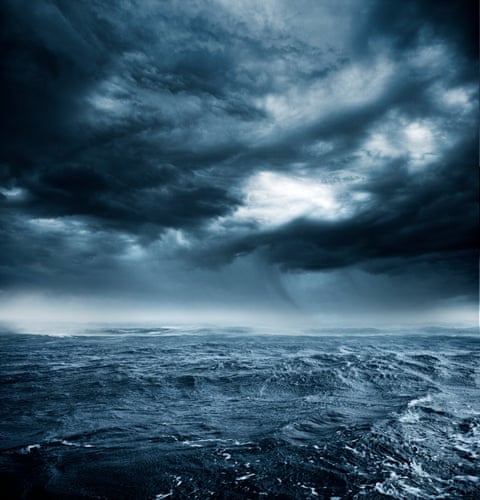

Dark waters: how the adventure of a lifetime turned to tragedy
The Clipper round the world yacht race was created for amateurs seeking the ultimate challenge. But did they underestimate the risks?
O n 18 November 2017, Simon Speirs, 60, a retired lawyer from Bristol, was hauling on his waterproofs below deck on a yacht in rough seas in the Southern Ocean. For nearly three months, he’d endured cold, cramped quarters, soaked clothing, sea sickness and very little sleep. As one of the crews competing in the Clipper Round the World yacht race, Speirs had completed more than 13,000 nautical miles since leaving Britain, but the wild remoteness of the Southern Ocean was more challenging than anything he had experienced before.
Speirs had a hacking cough and a heavy cold, but as leader of the watch he had to get out on deck. The race had so far taken them across the northern Atlantic Ocean to Uruguay and back across the southern Atlantic to South Africa. Two months in, he’d asked for a break. But after only a week his replacement had fallen out of his bunk and hurt his wrist, and Speirs had to resume his role.
By 2pm, the wind was getting stronger; the yacht lurched up and down waves the size of steep hills. The captain ordered the crew to change the headsail to make the boat easier to control. Speirs made his way to the foredeck, but, at that moment, a massive wave hit, sweeping him over the side.
Speirs was still attached to the boat with a tether. For several minutes he was dragged behind the boat in the roiling waves, while the crew tried to haul him back in. Then the clip on his harness snapped, and he lost contact with the yacht. It took three attempts and 32 minutes to pull him back on board, by which time he was dead.
Simon Speirs is exactly the sort of person Robin Knox-Johnston, the veteran sailor, had in mind when he founded the Clipper Round the World yacht race more than 25 years ago. At that time, the only people who got to race boats around the world were professional sailors. Clipper was designed for ordinary people: offering training and the opportunity to join a mixed-ability crew, it would enable customers to achieve the ambition of a lifetime.
The race is held every two years. Eleven yachts, each with a paying crew of 16-22 amateurs, led by a professional skipper and a qualified first mate, start from an English port, and take up to 11 months to cover 40,000 nautical miles. Paying crew can choose to do one or more legs of the journey, and it isn’t cheap. To take part in the whole race, over seven or eight legs, costs around £50,000. The route takes in some of the world’s most treacherous seas, but you don’t need any sailing experience to participate. According to Clipper Ventures, the company that runs the race, around 40% of participants are complete novices. Since it began, the race has become hugely popular.
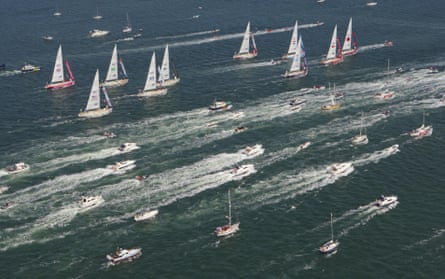
Clipper Ventures is not the first outfit to sell an iconic and dangerous challenge to amateurs. On 23 May 2019, 354 climbers made it to the top of Mount Everest in a single day . This included a dentist, an architect, a surgeon, a CEO and a housewife, who had each paid between £33,000 and £100,000. The oldest was 64. The commercialisation of extreme adventure has been made possible by advances in technical equipment like satnav and portable oxygen metres, and turbocharged by a hunger for personal growth and fulfilment. But it has also been accompanied by accidents and tragedies. May 2019 was one of the deadliest seasons on record: 11 climbers died on Everest in nine days . According to reports, overcrowding and underprepared climbers were partly to blame.
There have been other fatal accidents on the Clipper race, too. On 4 September 2015, Andrew Ashman , 49, a paramedic from Orpington, south-east London, was standing in a known danger zone in the yacht’s cockpit area when he was struck by the boom and suffered a fatal neck injury. Six months later, on the same boat, Sarah Young , 40, an entrepreneur from London with no previous sailing experience, died after being swept overboard by a wave. She was not clipped on.
According to a report by the Marine Accident Investigation Branch (MAIB) into Speirs’s death, published in June 2019, 17 people fell overboard from Clipper yachts between 2013 and 2018. Just over two weeks before Speirs went overboard, a Clipper yacht ran aground and had to be abandoned in a “very serious” incident just off the coast of South Africa. An MAIB investigation into that incident published in June 2018 concluded that the inexperience of the crew was a factor: “With only one professional, employed seafarer on board, the Clipper yachts were not safely manned for the round the world race.”
“If you read Clipper’s material, you’d think their number one concern was to keep people safe, but they have failed in so many ways,” said Margaret Speirs, Simon’s widow, when we first met in 2020. “I believe the company is compromised by their desire to make money out of these races.”
Knox-Johnston has strongly denied such claims. “Safety is a core principle of the Clipper Race, ahead of the racing element of the event itself, and therefore the most important part of the training of its crew,” Clipper Ventures said in a statement to the Guardian. The company says it has made investments in safety gear, becoming “the first ocean-racing company to introduce personal AIS beacons into its lifejackets to aid recovery of a man overboard”.
After the deaths of Ashman and Young in the 2015-16 race, the future of Clipper looked uncertain, a source who works at Clipper Ventures told me. “I thought, nobody is going to want to sign up.” But, in fact, applications increased. People are drawn by the chance to do something exceptional – and the risk is part of the attraction. Many customers, the source said, tend to think: “This is really dangerous! This is something I’ve got to do!”
T he founder of Clipper Ventures, Knox-Johnston, became the first person to sail solo around the world , without stopping, in 1969. In the memoir he published soon after his return, he describes the hardships he endured. His boat leaks, his water supply gets polluted, his steering gear is smashed, he shoots a shark when it comes too close, and suffers what was later diagnosed as a burst appendix. He carries on, undaunted. This, it seems, is the Knox-Johnston way. At the age of 68, he became the oldest person to race solo around the world. He had got irritated with people saying he was past it.
In the autumn of 1995, the same year he received a knighthood, Knox-Johnston placed newspaper ads to see how many people would be willing to pay to become part of a round-the-world crew. The response suggested that there may be a viable business in the idea. William Ward, a former property developer, who became CEO of Clipper Ventures, invested £1.8m.
Knox-Johnston commissioned eight new boats – Bluewater 58 sloops – from Colvic, a shipyard near Chelmsford, Essex. The company set up a base in Plymouth, Devon, and Knox-Johnston recruited friends from the sailing world, many ex-servicemen, as skippers. As soon as the boats were completed, they began training crew, taking on additional skippers as they went.
On 16 October 1996, the first race left Plymouth with the eight boats. The race was a success, and over the next few years Clipper built itself into an international brand. Major companies started to sponsor the boats (Garmin, Nasdaq), as did charities such as Unicef, and, from 2002, British cities such as Leeds, Liverpool and Glasgow. “Since the first race in 1996, the event has been transformed from a low-key amateur sailing race into a major, and highly profitable, international event attracting the interest of the world’s media and business leaders,” wrote Ward in Clipper company accounts in 2007. In the following years, the company continued to grow.

After the 2011-12 race, the company upgraded its yachts, and launched the new Clipper 70s, manufactured in China. They were longer and faster than the previous yachts, reflecting Clipper’s ambitions for more exciting racing. In 2018, Clipper expanded its business to Asia with the launch of a China-based division, Clipper China. In 2019, the company made a profit of £3.2m; by 2020 it had a staff of 86.
The man at the heart of this success, Knox-Johnston, is, in the words of the Daily Mail , “a patriotic Englishman of the old school”, who “embodies the spirit of the stiff upper lip”. He has little time for what he sees as unnecessary bureaucracy. In his autobiography, he criticised the Maritime and Coastguard Agency (MCA), the government department that enforces safety at sea and sets standards for the Clipper race. Knox-Johnston complained about its ridiculous and “inappropriate” rules for small racing yachts.
Knox-Johnston sees the race as a life-changing opportunity. Ben Bowley, a skipper and chief instructor, who worked for Clipper Ventures for nine years from 2011, was impressed by Knox-Johnston’s vision and belief. “He has drive, passion and his ability to convey the awesomeness [of the race] is quite captivating.” Having completed the race, Knox-Johnston wrote in his autobiography, people “usually feel confident to take on greater challenges”. He continued: “They have painted their lives with bright colours, not pastel shades, and that brightness is like a drug and they want more of it.”
T he moment Simon Speirs decided he was going to sail around the world came in 1992, when he was in his mid-30s. Watching the first TV footage of the Whitbread Round the World race, he was entranced by the huge seas of the Southern Ocean. “It then became more a case of ‘when’ rather than ‘if’,” he later wrote on his blog. Ocean sailing was his wife’s idea of misery, but she understood his obsession. “Simon was excited about it. It was his retirement dream to do it before he was too old, too infirm,” she said.
Speirs, a senior partner in a Bristol legal firm, was meticulous and thorough. He liked to-do lists and DIY, and had a dry sense of humour. He also had an adventurous side. Every two years he would take on a challenge to raise money for charity: he had climbed the Three Peaks (the highest mountains of Scotland, England and Wales), cycled from Land’s End to John O’Groats, run a 66-mile race in the Lake District.
Speirs originally signed up for the 2015-16 race. But he deferred his place because work was busy and his oldest son was getting married. Better to wait until the next race, 2017-18, when he would be 60 and newly retired. He kept fit by cycling six miles a day to work.
Speirs was a keen amateur sailor. He kept a couple of dinghies on a reservoir in Chew Valley, Somerset, where he had “sailing Sundays” with his children. He had a son and a daughter with his first wife, who died in 1991, and two sons with Margaret, whom he married in 1996. He had skippered chartered yachts on family holidays in the Mediterranean. “But that in no way compares with the experience of these huge racing yachts in these wild oceans,” said Margaret.
Training for the Clipper race consists of four courses, levels 1-4, each lasting a week. This process, which is compulsory for participants, covers basic sailing techniques – headsail changes, tacking, gybing, helming; as well as race strategy and safety. Trainee crew also sail offshore, mostly in the Solent, and later spend a few nights in the Channel. “The Solent and the Channel are widely recognised as one of the best sailing grounds in the world for training,” said a spokesperson for Clipper Ventures, because “of the complexity of tides, shipping, navigational hazards and inclement weather”.

The people who sign up for the Clipper race tend to be middle-aged men of means. Many are at a turning point in their lives: just divorced, promoted, retired, bereaved, recovering from illness. Nathan Harrow, then 43, a business consultant, decided to sign up as a round-the-worlder in the 2017-18 race after a period of stress and depression after redundancy. “Clipper was me drawing a line under the old me and getting my confidence back,” he told me.
Mary Morrison, a mentor for troubled children, from south-west London, was 65 and perfectly content with her life, when she did the 2015-16 race. “One of the guys I was sailing with said, ‘You’re the one least after change, but you’ll probably change the most’, and that was probably true,” she says. She gained new friends, an appreciation of the scale and sheer beauty of our planet, and a sense of how we need to look after it more. “And it gave me a lot of confidence,” she said. Another woman in her 60s, who did the third leg of the 2017-18 race, told me it was the best thing she had ever done.
Crew are assigned to each yacht a few weeks before the race. The aim is to balance experience and ability across the fleet. Whether everyone gets on is a matter of pure chance. “It’s one big social experiment,” said a crew member who did the race in 2007-8 and again in 2017-18. “If you’re lucky, you have a good time. It’s partly to do with the characters involved.”
Each boat is certified for 24 people including one skipper, who in 2017 was paid about £38,000 a year, plus £150 a day for six months of training beforehand. (“We ensure that our skippers share Clipper Ventures’ ethos of safety above all else,” said Clipper Ventures. “Anyone who fails safety standards is dismissed.”)
For many years, Clipper were required to have two professional sailors on board during the race, under the MCA’s small commercial vessel code. However, a freedom of information request shows that in 2010, Knox-Johnston lobbied the MCA to allow him to replace the second qualified person with a trained-up member of the fee-paying crew. The MCA refused. In 2012, with the MCA under new leadership, Knox-Johnston tried again. “We have tried to make the system of having two qualified people aboard each boat work,” he said in a meeting with the MCA on 1 August, but, he said, it is “not financially sustainable”.
Knox-Johnston had a subsequent meeting with the MCA at Clipper’s base in Gosport, Hampshire, at the end of September. Details of the meeting were not released. A year later, in October 2013, the MCA granted Knox-Johnston’s wish. From that point on, it wouldn’t be necessary to have two professionals on board. All that was required was one fully qualified skipper, and a second person who had successfully completed the company’s coxswain training course.
The Clipper coxswain’s course lasts 12 days, and is paid for by Clipper. The company aims to have two people on each boat who have taken the course, which covers use of radar, reading wind direction and force from a chart, calculating tidal flow and ocean currents, and manoeuvring the yacht safely into a berth in a port or harbour. Some sources I spoke to were sceptical about whether this training is really a match for hands-on experience. “As a professional sailor you’re trained to look and see things that are going wrong ahead of catastrophe,” said one skipper. “You’ve got to have this ability to stand back and look at the whole picture, all the time.”
After the deaths of Ashman and Young in the 2015-16 race, the MAIB urged Clipper to review its manning policy. “The special nature of the Clipper Round the World yacht race places a huge responsibility on one person to ensure the safety of the yacht and its crew at all times,” the MAIB wrote in April 2017.
Four months later, the 2017-18 race started without a second paid professional on board any of the boats.
T he race was not quite what Speirs had imagined. Seven weeks in, he described the trip on his blog as “acute discomfort mingled with elation and awe”. High points included the “beauty of the sky at night”, the “soft swish” of the boat through calm sea, the camaraderie of the crew and an encounter with a pod of dolphins. Less enjoyable was the sea sickness, the cold and the lack of sleep. Speirs had dropped two trouser sizes since the start of the race, a fact he attributed to the physical effort of sailing. Pulling ropes. Grinding winches. “I miss you very much,” he wrote in a letter to Margaret, on 10 October. The experience, he said, was “not a barrel of laughs”. But he still planned to complete all eight stages. “I am too stubborn to drop out,” he wrote on his blog.
Not all of his fellow crew members were so reluctant to quit. Mark Tucker, then 40, had signed up to do the whole Clipper 2017-18 race and was assigned to Great Britain, the same boat as Speirs. (The boat was sponsored by the British government, as part of a marketing campaign to attract tourism and investment; on 2 August, the crew were photographed outside 10 Downing Street .) However, Tucker left after the first leg because of his concerns about safety. He felt that there was insufficient time before the start of the race for maintenance and repairs to the boat. At the time, he wrote a resignation letter to skipper Andy Burns, explaining his thinking, but he wasn’t able to speak candidly in public because he’d signed an NDA. “In retrospect,” Tucker told me, “I view them very much as a media/PR company that happens to do a bit of sailing, rather than the other way around.”
By the end of the second leg, Speirs was exhausted. At the end of the 10-day stopover in Cape Town, South Africa, he wrote on his blog that he had used the layover to “repair and recharge”. He went to bed early and ate healthily. He got his haircut and met up with his daughter, Katherine, and her husband. She gave him a fruit cake baked by her mother-in-law.
On 31 October 2017, the Clipper boats began the third leg of the race: Cape Town to Fremantle, Australia. A journey of more than 4,700 nautical miles, it would take about 23 days and pass through the Southern Ocean, one of the world’s most dangerous waters. An area of almost constant high wind and frequent gales, it is where one of the highest ever waves was recorded – 120 feet.
For this third leg, the crew had dropped from 20 at the start of the race to 16. The average age was 50, but the overall sailing experience was greater than on the previous two legs. Tim Jeffery, then 56, an architect from London who had sailed small boats for 15 years, had signed up for the first leg “to get to know people”, and the third leg for the Southern Ocean. “It is the most remote place in the world,” he told me. “The sea is dramatic. It’s challenging because of the size of the waves. You also get very fast sailing and it’s hard work.”
The crew was divided into two groups operating a system of five watches a day: two shifts of six hours from 8am; three shifts of four hours from 8pm. Everyone was given a job: engineer, medic, treasurer. As well as head of his watch, Speirs was the nominated sail repairer. He became known as “Tailor of Gloucester” on account of the hours he spent at the sewing machine with glasses perched on the end of his nose.
Speirs was also the Clipper coxswain, regarded as the skipper’s second in command. Great Britain had actually started the race with three paying crew members who had completed the Clipper coxwain’s course: one was Tucker; the other, apart from Speirs, was Jon Milne, then 50, an IT director, who was injured at the time of Speirs’s accident. A common theme of Speirs’s blog was that he felt overworked.
Everyone on Great Britain was delighted with their captain, Andy Burns. Then 31, Burns had started sailing as a schoolboy in Lincolnshire. After working on superyachts and for the Royal National Lifeboat Institution, he joined Clipper Ventures as an instructor in 2015. This was his first race as skipper.
Speirs regarded Burns as an ally. Both were good with people, patient, enthusiastic. Burns prioritised safety over speed. He “assessed the abilities and limitations of his crew to the extent that, during leg two, he made the decision not to race competitively, but to sail conservatively”, according to the June 2019 MAIB report.
Once the boat was sailing through the Southern Ocean in extremely cold weather, the shortage of experienced hands became a problem. Speirs wasn’t able to rest as there was no one to take his place. “The boats are set up for a certain number of crew,” according to a source at Clipper Ventures. “You need that many people to be able to work the boat. If you’re one or two people down that’s very problematic, and of course it makes the rest of the crew tired.”
After the 2014-15 race, a fitness test became part of the interview. Crew have to show they can climb on to a top bunk (not so easy when the boat is listing at 45 degrees) and get on the boat without using a ladder. The source said they felt Clipper Ventures’ vetting process needed to be tougher. Being at sea can be petrifying. “People become frozen with fear and start behaving out of character and become very difficult because they’re frightened.”
One person, who did not want to give his name, signed up for leg three on Great Britain in the 2017-18 race. In the final week of training, the boats raced down to France and back. “The weather was hideous. We had 18 people on board and there was probably only four or five of us that managed to keep the boat sailing. The rest were incapacitated downstairs. I was burning myself out covering for other people. When we pulled up into the dock, I packed my bags and I said, I’m done, it’s not safe.”
The dropout rate among round-the-worlders is 40%, wrote Speirs on his blog. Things must get very bad, because crew are liable for 100% of the fees if they drop out during the race. “People remortgage homes and invest significant amounts of money in the adventure,” said one former crew member. “Sometimes as much as £100k if you include insurance, food, accommodation, flights, kit etc. It’s going to take something pretty serious to knock them off course.”
A part from injuries and fatigue among the crew of Great Britain, a major concern was the condition of the boat. In an email to Clipper’s management on 3 July 2017, six weeks before the start of the race, Speirs had pointed out that Great Britain was leaking. “Still working hard to keep water out. Not easy job and pretty hairy when boat kicking around. This should have been sorted out at refit before handover. It’s a safety issue,” Speirs wrote in his blog on 12 August.
The boat was still leaking when it left Liverpool on 20 August 2017. Within two days the generator packed up. The water maker, which turns salt water into drinking water, didn’t work for three weeks. “Andy [Burns, the captain] was spending his entire time dealing with maintenance issues on a boat that was three weeks into a year-long circumnavigation,” said Mark Tucker. “If he’s down below sorting out why the water maker doesn’t work or the generator doesn’t work, he’s not on deck coaching people, making sure the boat’s being sailed safely.”
As part of its investigation, MAIB singled out an issue with the guardrail and supporting stanchions, which may have been partly responsible for Speirs’s death. The guardrail, which was designed to keep crew from falling overboard, was damaged in rough seas on 4 November, 13 days before Speirs’s accident. The crew managed to lash up the guardrail by wrapping rope around it. “The repair was not great,” said Tim Jeffery. “We had to be extra careful on the foredeck after that.”
The MAIB report identified a series of problems with Great Britain. “The cumulative effect of the defects was to increase workload for the crew, contributing to their fatigue, lowering morale, and distracting from sailing and gaining sailing experience,” it stated.
There were problems on other boats. Unicef had to be bailed out every four hours, on legs one and two, according to one round-the-world sailor. Unicef started the race with a broken fuel pump. The generator failed on the first leg. Two crew members who had signed up to do the whole race left Unicef after leg two, saying they were unhappy with the number of problems with the boat that needed attention.

Staff at Clipper put the malfunctions down to normal wear and tear. The boats had been around the world twice at that point, they say, as well as being used in training and for corporate events. “Some people believe that because they are paying to go around the world, the boat should be like hiring a car,” said Lance Shepherd, skipper on Liverpool during the 2017-18 race. “Everything should be immaculate, ready to go. But that is not how boats work. They are much more fickle and difficult to maintain.” Clipper’s management was prudent, he said. “They put safety first and foremost.” The boats “get stripped right back and overhauled” at the end of every race.
But there were also problems with the Clipper 70s from the outset. Clipper Ventures first discovered an issue in 2013, when the new hulls were shipped to the UK from China. There were gaps in the layers of fibreglass-type material, which could “make the boat more prone to cracks in extreme seas”, a marine surveyor told me.
Clipper had the entire fleet surveyed in February and March 2013. They had the “bad parts” cut out of the new boats and relaminated, according to Knox-Johnston. Not an easy job, given the scale of the problem, or the time frame in which repairs had to be done. The 2013-14 race was due to start in just over six months’ time. It couldn’t be delayed. Sponsors were signed up, the jamboree of corporate backers, supporters and families was already planned in each port.
Crew members later expressed concerns that there were too many problems to fix in the short time before departure. Garmin crew member Kira Pecherska, an experienced and highly qualified sailor, said there was no time for proper sea trials. “If you send a boat on a transatlantic journey, especially with beginners on board, who have no experience in sailing at all, at least these boats must be trusted. And you can only trust your boat when you test it.” (Clipper Ventures said: “Clipper Race yachts are well built, well tested and maintained by a dedicated and highly skilled maintenance team who travel to every port of call on the race route.”)
The source who works at Clipper Ventures told me there was anxiety about reporting problems: “There is a fear culture, that prevents a lot of that. They [skippers] are thinking, I’m going to get crucified for letting that happen.”
According to Clipper Ventures, on stopovers Knox-Johnston and Ward have “been accessible to all sailing staff and crew for any questions or concerns. They created a culture of openness and this continues with all Clipper Ventures staff today.”
A t about 2pm on 18 November 2017, Simon Speirs came up on deck, wearing a foul-weather jacket and salopettes. Conditions were rough: his fellow sailors had never seen such massive seas. His wedding ring was tied around his neck on a leather shoelace: jewellery was considered a safety hazard on board. He was one of five crew on the foredeck lowering the headsail. He was attached to the deck with a safety tether.
At 2.14pm, Great Britain was hit by a huge wave. The yacht dropped into a trough, slewed violently, and Speirs was thrown into the water. One crew member, who did not want to be named, saw Speirs with his lifejacket inflated, being dragged alongside the boat. He leaned over to try to grab him, but Speirs was just out of reach. He tried pulling on the tether, but the boat was going too fast. He could see Speirs was struggling as the water buffeted him. “He was constantly being hit by the waves. Never able to gather his breath.”
The crew member managed to hand Speirs a rope with a lifting hook to attach to his lifejacket, in order to winch him out of the water. Speirs tried to clip the rope to his lifejacket, but he was getting exhausted. “Water was going over his face and he was being bashed against the side of the boat.” As Speirs was dragged through the sea, his clip bent out of shape. At 2.22pm, it snapped open.
“My immediate thought was, thank God, he’s not going to drown by being dragged along by this boat,” said the crew member. “We can get the boat under control and go back and get him. We’ll get him in two minutes. It’s not dark. It will be fine.” But turning the boat around in strong wind and very rough seas was not easy. It took three attempts to retrieve Speirs from the sea. Finally, at 2.54pm, 40 minutes after he fell in the water, six crew lifted Speirs on board Great Britain. His lifejacket was cut off and crew carefully carried him below deck. He was already dead.

After Speirs’s body was brought aboard, the skipper radioed to the Australian coastguard. Clipper tried to contact Margaret, but when they couldn’t get through they called the family home and broke the news to their son Toby. “They told him his father had died,” said Margaret. “A 17-year-old lad who is on his own at home. Toby is a sensible lad but I’m sure it has scarred him for life. Clipper did wrong by us, very wrong by us.”
“We tried to contact Mrs Speirs, Simon’s emergency contact. Unfortunately she was not at home and her mobile phone was switched off,” said Jeremy Knight, then chief operating officer at Clipper Ventures, in an email to the crew of Great Britain, after being informed that the Guardian was investigating Speirs’s death. “This decision to break the news to Simon’s son has proved difficult for the family, and we understand that,” Knight wrote. “But the alternative, holding off and risking the family finding out through the media, was much worse.”
At 7pm that evening, the race director called Margaret and told her that her husband would be buried at sea in eight hours. “He was not giving me any options. He told me they had come to that decision for the benefit of the crew so that they wouldn’t have to travel with Simon’s body on board. And they told me the burial at sea would be at three o’clock in the morning our time. And by three o’clock in the morning we did have some friends and family gathered. The vicar came and we read the service at home that they were having in the Southern Ocean as if we were sharing it.
“The burial at sea has robbed me and my family of the opportunity of laying Simon to rest at a place of our choice and allowing us to say goodbye to him in a way that we would have wished to,” she continued. “It has also deprived our family of the opportunity for a coroner’s inquest. We didn’t get a chance to put questions, hear the responses, to help us understand what happened.”
Burns quit Clipper Ventures at the end of leg four. “Andy didn’t enjoy a second on that boat after Simon died,” said the crew member who had tried to rescue Speirs. Jeffery didn’t do the final leg, as planned. After Speirs’s death, he did not feel right leaving his wife and two daughters.
After Speirs’s death, the MCA would not allow the Clipper boats to sail with only one professional onboard. Clipper Ventures had to recruit a second qualified mate for each boat in the fleet for the rest of the 2017-18 race.
The MCA investigation into the death of Simon Speirs was closed in 2020. “The MCA received strong legal advice that the evidence was not enough to bring a prosecution,” stated a spokesperson. The MCA referred the case to Hampshire police to follow up an allegation of fraud in the certification of the boats, and they concluded that there were no grounds to pursue an investigation.
Ward was awarded an OBE in 2018 for his services to the economy and to the Great Britain marketing campaign. Knight retired from his role as COO of Clipper Ventures in April 2022 and is currently a magistrate. When we contacted Knox-Johnston in November 2022, he was at sea.
One bright morning last month I spoke to Speirs’s sons Mike and Toby on Zoom. For more than two years, the family had been fighting a civil action against Clipper Ventures, charging the company with an “immature safety culture”. They wanted to make Clipper Ventures answer for some of the failings that had led to their father’s death. “If you offer a service that is dangerous you have a responsibility to make it as safe as is reasonably possible and I don’t think that was done,” said Toby.
At the end of February, Clipper Ventures paid the family the net sum of £140,000 to settle the case. The family believe the timing of the settlement was no accident. Clipper Ventures is up for sale. In settling the case, the company admitted no wrongdoing. But the family felt vindicated. They donated the money to the RNLI.
Nothing can make up for the loss of their father. Toby is a student at his father’s alma mater, Queens’ College, Cambridge. “I just wish I could talk to Dad about that,” he said. Mike longs to tell his father about the grandchildren he never knew.
For Margaret, the settlement has brought a sense of relief. “I can hang up my sword and put all things to do with Clipper Ventures behind me,” she told me recently in an email. Simon Speirs had always been a loving husband and father. Now they could once again remember him not just by the way he died, but as the remarkable man he was.
This article was amended on 11 May 2023 to correctly refer to the Solent, rather than the “River Solent”.
- The long read
Most viewed
Scotland's sustainable sailing capital
Celebrating sailing adventures in argyll and the isles.
A press release from Destination Management Organisation (DMO) Argyll and the Isles Tourism Cooperative (AITC) has, this week, launched a bid for Argyll and the Isles to be known as "Scotland's Sustainable Sailing Capital".
This ambition celebrates the sustainable nature of sailing and the large volume of innovative sailing businesses and events in the area that go the extra mile to ensure their breath-taking experiences help to protect, restore and enhance their outstanding natural environment.
With an exciting year ahead for the region's maritime sector, including welcoming the Clipper Round The World Yacht Race to Oban in July, it's no wonder sailors of all abilities, from around the world, are in agreement that Argyll and the Isles is uniquely placed to enjoy some of the best sailing adventures and make a positive impact on the local environment.
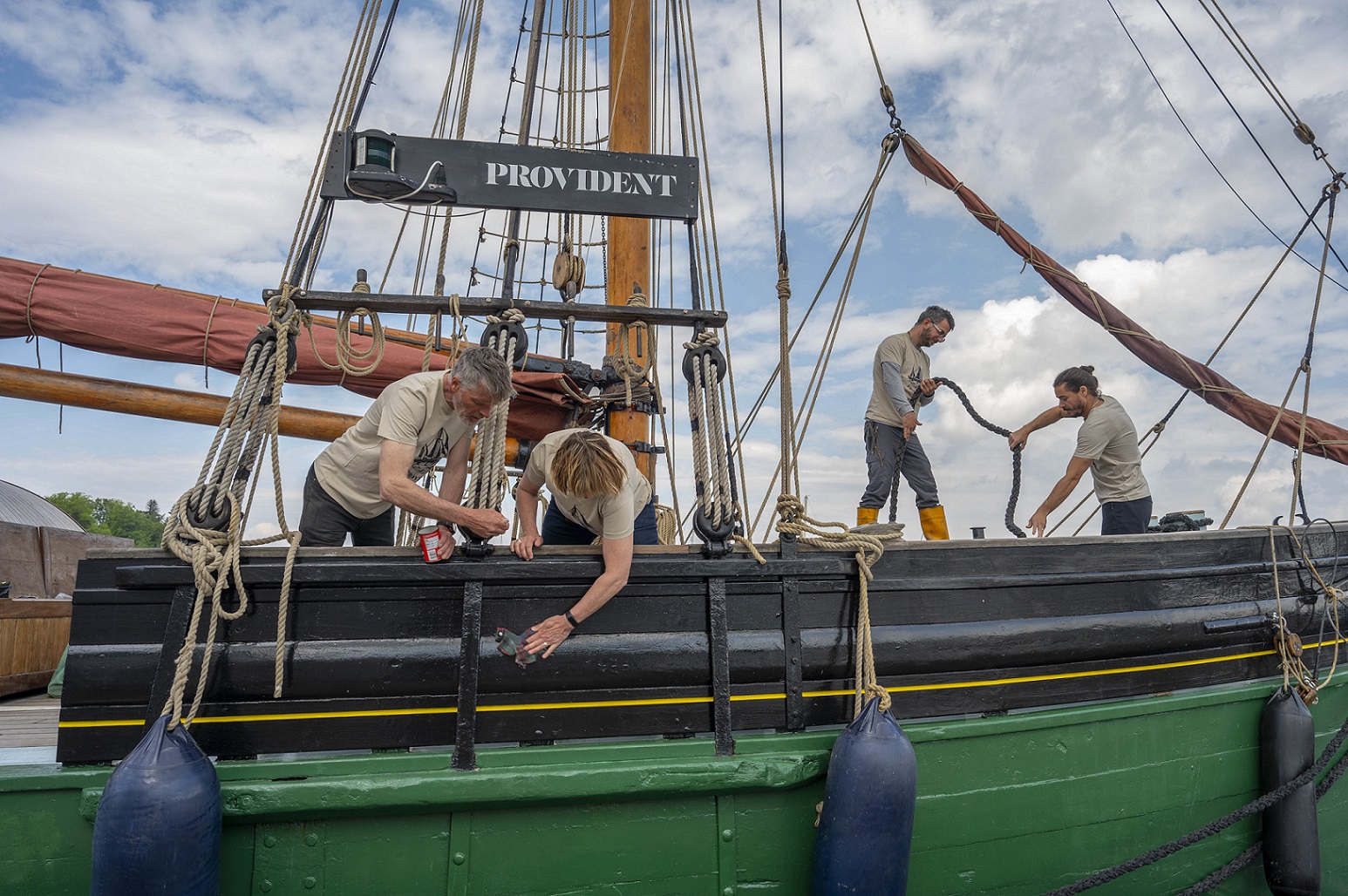
Crew preparing Provident for her centenary year voyage. Credit Wild About Argyll / Phil Wilkinson
The businesses making waves
The bid to be known as "Scotland's Sustainable Sailing Capital" wouldn't be possible without the businesses and organisations committed not only to providing outstanding experiences, but doing so in a way that protects the environment around them. Here's what's happening across the region in 2024:
Clipper Round the World Yacht Race
For the first time in its 27-year history, the Clipper Race will be making its penultimate stop in Scotland when it arrives in Oban in July 2024. It's renowned as one of the toughest endurance challenges on the planet, welcoming adventurers from all walks of life to take on the exceptional challenge of racing across the world’s oceans on board a 70ft yacht. Their historic first visit to Scotland will be celebrated through a range of events and festivities. Find out more about the Clipper Race coming to Oban on the official race website.
Responsible sailing adventures
Stravaigin Sailing harness the power of the wind and sun for their sailings to reduce the need for fossil fuel engines and generators. They also educate their visitors on how to care for the local environment.
Their Skipper Jon Ormiston said: “Stravaigin is an old Scots word meaning 'to wander' - we like to think that encapsules our ethos of immersive, sustainable slow adventures, exploring and discovering new landscapes, experiences, foods, cultures and creating meaningful experiences that linger."
Committing to the Green Blue Pledge
The Royal Yachting Association (RYA) Scotland is encouraging sailors visiting the area to support the Green Blue Pledge. The pledge has been created for boat users to actively declare their commitment to following sustainable boating practices with simple and practical guidelines.
Other activity in the region
- Argyll-based Provident (one of the last sea-going Brixham Trawlers which featured in the latest BBC series of Traitors) is embarking on a special voyage to celebrate her centenary year
- the founder of Wavysail is launching a pioneering initiative to develop low impact adventure yachts
- Basking Shark Scotland is leading eco-conscious and educational wildlife tours
- Tighnabruaich Sailing School is preparing to celebrate its sixtieth year
Sustainable and responsible tourism are the keys to developing Scotland's visitor economy. More than ever, consumers are attracted to environmentally sensitive businesses and destinations that support them. With an outstanding maritime environment and some of the best sailing in the world, Argyll and the Isles thoroughly deserves to be Scotland's Sustainable Sailing Capital. David Adams McGilp, Regional Director and the Marine & Coastal Tourism Lead at VisitScotland
Find out more
Visit the Wild About Argyll website for more information about sailing in the region.
Related links
Scotland visitor survey 2023 summary, promoting meaningful travel experiences, reduce your climate impact guide, winner of scotland’s greatest escape 2024 revealed.
- Crew Login Forgotten Password
Enter your details below for the race of your life
Select a race
Race 11 - day 12 skipper report 16 may.

Another couple of days have passed and you won’t be surprised to know that not much has happened. We are still flying our Code 1 and it hasn’t come down for nearly a week now. The whole crew has been helming the whole time, so everyone has gotten pretty good now. The only downside to the perfect sailing conditions is the lack of entertainment and excitement that sail changes and challenging conditions bring, but we found salvation a couple days ago though and that salvation came in the form of boobies.
Boobies are a rather odd looking and very curious bird with large round heads and eyes that stick out and always seem to stare at you in a slightly confused yet standoffish look. They've suddenly taken to providing crew entertainment with the slightly odd things they seem to get up to. Yesterday, we had a young one land in the back of Dare To Lead , behind the helm cage, it hung around for a photoshoot and a gybe before realising it was going to struggle to get off as it was too big to fit though the netting. I wondered over to try and help it. Deciding I’d got plenty close enough, it flapped up onto the side of the boat and tried to fly away, got its wing caught on some of the string and then had to flap around a little to break free before ungracefully dropping into the water.
About five minutes later it tried to land on our pulpit but it misjudged its approach, hit the Yankee hanked onto the forestay and fell into the water again. We hope he gets better at flying soon.
Today we've had one land on the top of our mast right next to our precious windvane, seeming to want to stay the night, and it’s still there now despite our best attempts. We've clapped at it, shaken the backstays to wobble the mast shone our spotlight at it and yet he seems unphased. Will our wind instruments survive this advancement? Tune in in two days' time to find out, but if you see us going off at strange angles to the rest of the fleet you could safely assume that's why.
Charlie, Ryan and the DTL crew

IMAGES
COMMENTS
We may use the information we collect about you to notify you from time to time about updates on the Clipper Round the World Yacht Race, Clipper Training and Clipper Events and important new features related to the Clipper Race, as well as changes to our online services, special offers, competitions, surveys or promotions and other programmes ...
Team Partner. Host Port Partner. Team Partner. Team Partner. Team Partner. Host Port Partner. Team Partner. Team Partner. Host Port Partner. Team Partner. Host Port ...
30 August 2023. Clipper 2023-24 Race Gunwharf Quays Portsmouth Race Start. It's Day 1 of the Race Start celebrations in Gunwharf Quays, Portsmouth and the Race Village is officially open! Image: Clipper Race fleet berthed in Gunwharf Quays ahead of the Race Start on 3 September. From today until 3 September, Gunwharf Quays will host the ...
Leg: The Australian Coast-to-Coast. Marina: Fremantle Sailing Club. Arrival Window: 8 Dec 2023 - 13 Dec 2023. Race Start: 19 Dec 2023.
Clipper 2023-24 Round the World Yacht Race crew members. 02. 1 nautical mile (nm)= 1.852 kilometre and 1.15 miles. GLOBAL CIRCUIT. THE 40,000 NM RACE ROUTE SETS OUT AN INTRIGUING MIX OF SAILING ...
Ha Long Bay, Viet Nam has claimed its fourth win on the Clipper 2023-24 Race, taking first place in the longest, and one of the toughest races on the circuit, Race 10: Ultimate Test of Perseverance - the 5,580nm North Pacific crossing. The Ha Long Bay, Viet Nam team, finished in 25 days, 19 hours, 26 minutes and 11 seconds, with the crew ...
The Clipper Race is one of the biggest challenges of the natural world and an endurance test like no other. With no previous sailing experience necessary, it's a record breaking 40,000 nautical ...
The eleven skippers set to lead teams of amateur sailors from all walks of life around the globe has been revealed. Hailing from the UK, Uruguay, Portugal, South Africa and the Netherlands, the skippers appointed to lead their teams on the Clipper 2023-24 Race have collectively sailed over a million nautical miles collectively and bring a vast ...
Race 1 of the Clipper Round the World Yacht Race has finished with Perseverance taking the win of the first race of the circumnavigation. After the epic Race Start from Portsmouth, UK on 3 September and the fleet bound for Puerto Sherry, the conditions have made for an interesting competition with plenty of tactical racing required from the eleven teams during this race to Spain.
Published on May 6th, 2024. The 2023-24 Clipper Round the World Yacht Race is on the move again for the 4200nm leg down the western coast of North America from Seattle, WA to Panama. The 11 teams ...
Founded by Sir Robin-Knox Johnston, the first person to sail solo, non-stop, round the world, the Clipper 2023-24 Race is the thirteenth edition of the biennial race. Taking 11 months to complete, over 700 crew aged from 18 to 75, who are students to CEOs, from 45 nationalities after four weeks of intensive training are participating in the ...
Ha Long Bay, Viet Nam has claimed its fourth win on the 2023-24 Clipper Round the World Yacht Race, topping the fleet of eleven 70-foot yachts on the longest and toughest race on the circuit.
Image source, Clipper Round the World Yacht Race. Image caption, ... The Clipper 2023-24 Race team will also mark its first ever visit to Washington, DC, in June 2024, completing the seventh leg ...
The Clipper Race has revealed Portsmouth will be the location for the Race Start and Finish of its 2023-24 edition. Five days of festivities, beginning 30 August 2023, are planned for Gunwharf Quays, the neighbouring harbour of the sailing company's operations for almost 20 years. The only event which trains people from all walks of life to ...
Preparing for Clipper Race 2023-24. Published on August 30th, 2022. The 2019-2020 Clipper Round the World Yacht Race was to finish in just under one year, but when the teams arrived in Asia during ...
As per the Sailing Instructions, two penalty points will be awarded to the relevant yacht when the running total of sail repair and replacement costs exceeds £500, and a further two penalty points will be awarded for every subsequent £500 for the duration of the Clipper 2023-24 Round the World Yacht Race.
The official souvenir magazine of the Clipper 2023-24 Round the World Yacht Race. Follow the epic race around the world on its 40,000 nautical mile, eleven-month extreme endurance challenge at www ...
The 11 teams competing in the 2023-24 Clipper Round the World Yacht Race will embark on Leg 4 of their journey, starting from Fremantle, Australia. This leg will take them on a challenging 2,500nm course around the southern coast of Australia up to Newcastle, New South Wales, including tough weather conditions and the most southerly point of ...
Clipper Round the World Yacht Race, Gosport, United Kingdom. 128,743 likes · 2,980 talking about this. The #ClipperRace attracts people from diverse walks of life who train to become ocean racing...
"The special nature of the Clipper Round the World yacht race places a huge responsibility on one person to ensure the safety of the yacht and its crew at all times," the MAIB wrote in April 2017.
Race 11 - Day 12. Skipper Report. Everything is going good on board Yacht Club Punta del Este. The crew is massively improving at the helm which brings out all the smiles, including mine. Everyone loves the helm. We are beautifully sailing downwind, tack is flying high, we are gybing south and east every time, often peeling from the Code 2 to ...
Race 11 - Day 12Skipper Report16 May. Race 11 - Day 12. Skipper Report. Today the heat has been turned up, no cloud cover has meant the deck has been hot. Boat exercise is conducted in the early hours of the morning. The sail locker is now open for stifling hot sleepers, as the ventilation is better there.
Race 11 - Day 408 May. Race 11 - Day 4. All is going well on board Punta. We are sailing without instruments, old school. We've tried everything to fix it and still no luck. We got them back for 20 minutes and we were so happy, but it didn't last too much longer. Last night was so much nicer than the previous.
In 2023-24, I will spend 11 months at sea in a crew of around 20 at any one time, on a 70ft yacht, as part of the Clipper Round the World Yacht Race. Leading up to, during, and after the race, I will share my journey and lessons learnt, including: the importance of living for today and going beyond your comfort zone.
Race 11 - Day 12Skipper Report16 May. Race 11 - Day 12. Skipper Report. The sailing has been fairly similar for the past week and a bit; variable wind but plenty of light wind sailing. This afternoon the wind eased off, so we completed our first kite peel for a few legs, which went so smoothly I didn't even wake up from my afternoon sleep!
Clipper Round the World Yacht Race For the first time in its 27-year history, the Clipper Race will be making its penultimate stop in Scotland when it arrives in Oban in July 2024. It's renowned as one of the toughest endurance challenges on the planet, welcoming adventurers from all walks of life to take on the exceptional challenge of racing ...
Race 11 - Day 12Skipper Report16 May. Race 11 - Day 12. Skipper Report. Another couple of days have passed and you won't be surprised to know that not much has happened. We are still flying our Code 1 and it hasn't come down for nearly a week now. The whole crew has been helming the whole time, so everyone has gotten pretty good now.
The town will welcome the final leg of the Clipper 2023-2024 Round the World Yacht Race which will coincide with a 10-day Festival of the Sea programme of events from July 12-21. Argyll and Bute Council is a Host Port Partner alongside BID4Oban and the Scottish Towns Partnership, which has part-funded the Host Port costs.